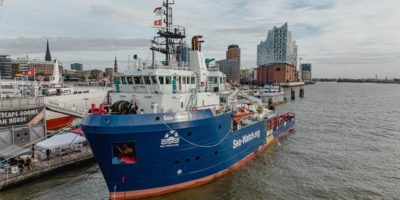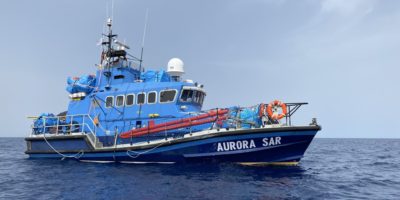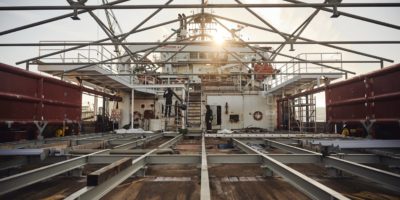With the present document, the signing non-governmental-organisations involved in search-and-rescue activities in the Mediterranean Sea, jointly share the following considerations and recommendations to the JHA Ministers reuniting in Luxembourg to follow up to the mini-summit of 23 September held in Malta. The question of a fair and human needs-based relocation mechanism remains unresolved. In recent months there have been repeated stand-offs of up to 19 days1 until a number of volunteering EU Member States (MS) have agreed on ad-hoc distribution schemes of relocation for the people rescued in the Central Mediterranean Sea. This practice contradicts international maritime and human rights law, in particular with regards to the obligation set by the legal framework applicable to search and rescue for bringing shipwrecked people to a “Place of Safety” (PoS)2 without any delay.3
Establishing a relocation mechanism for people rescued at sea by private ships is secondary to the wider problem of the ongoing severe violations of international human rights law occurring in the Mediterranean area against people who migrate. These violations are above all put in place through the cooperation of the EU Member States with third countries such as Libya, a country afflicted by a civil war, in which the so-called authorities are in strict connection with traffickers of human beings, and tortures and inhuman and degrading treatments are usually perpetrated against foreigners, as several Institutional reports denounced in details in last years. We reaffirm that the opening of legal entry channels from third countries, and humanitarian corridors from countries at war, constitutes the only real way to fight and dismantle smuggler networks in the Central Mediterranean.
Moreover, the lack of comprehensive and reliable figures and follow-up on the distribution of disembarked persons results in nontransparent relocation practices, as countries may often receive fewer people than originally pledged.4 Furthermore, current ad hoc mechanisms with little accountability are maintaining unequal treatment with regards to responsibility-sharing among the EU MS. In order to meet these concerns, the signing organisations wish to share a set of guidelines in light of the Council of JHA Ministers and having as reference the Joint Declaration of 23 September 2019 resulting from the mini-summit in Malta.
1. Temporary relocation as an accompanying measure
A temporary relocation mechanism does not replace a longterm solution and would provide only a fragile and illusory solution for the humanitarian emergency in the Mediterranean Sea. A lasting solution requires a reform of the Common European Asylum System (CEAS), including the Dublin Regulation and shall rest upon a solidarity principle, such as enshrined in the Treaty on the Functioning of the EU (TFEU). The European Council is still blocking the reform of Dublin III, ignoring a proposal by the European Parliament which has already been submitted in 2017. We welcome the reference made at point 15 of the Joint Declaration about the commitment “to advance on the reform of the Common European Asylum System on the basis of an initiative of the Commission”, nonetheless stressing the need to consider the power of initiative of the European Parliament to the matter.
We notice as well that the project outlined in the Joint Declaration includes clauses which make it very much dependent on unclear factors and leaves too much discretion to individual member states. In particular, point 15 of the Declaration stresses that “this mechanism as a pilot project shall be valid for a period of not less than six months and may be renewed subject to the agreement of the parties concerned or terminated in the case of misuse by third parties”, where it is unclear what is meant by “misuse”, and concludes adding that “should the number of relocated persons within these 6 months substantially rise the participating Member States will immediately come together for consultation. During the consultations, the entire mechanism might be suspended”. We must highlight how these conditions and variables weaken the whole concept by potentially reducing the approach, once again to an ad hoc mechanism.
2. Specific protection and human needs-oriented criteria for relocation in full compliance with international human rights law, refugee law, and EU asylum law
Any relocation scheme must at the same time ensure that countries of destination are defined by taking into account individual needs and connections such as family, community and social links conceived in a broad sense, as well as individual vulnerabilities and vulnerable groups including victims of violence, unaccompanied minors, disabled people, potential victims of trafficking and (sexual) exploitation in Europe but also that the relocation happens as swift as possible without avoidable delay. Furthermore, a relocation mechanism has to ensure that the agreement does not leave a gap of responsibility, leaving individuals in a bureaucratic grey area in which no MS is taking responsibility for their applications and interested persons don‘t have access to legal remedies.
3. No pre-screenings
Pre-relocation selection practices such as pre-screenings of individuals by MS harm the principle of non-discrimination of refugees as laid down in international law – the selection of persons eligible for relocation means in practice that the persons concerned may be unable to access the rights and benefits they are entitled to under the EU asylum acquis. Individuals must promptly be granted access to an asylum procedure, undergo vulnerability and best interests assessments, and benefit from the right to remain on the territory, as well as the right to adequate reception conditions such as accommodation and health care. In addition, pre-screenings risk the proliferation of so-called hotspots, as the country of arrival would need to create centres for such pre-screenings to take place in. The hotspot facilities, already existing in Italy, cannot guarantee a sufficient and detailed examination of the individual cases. Moreover, hotspots must not be used for the systematic detention of newly arrived foreign citizens and these have to have access to legal and social support for all the duration of relocation procedures, avoiding the risk of being isolated from guarantees deriving from the intervention of independent organizations and civil society.
Relocation should be automatic/immediate and should include all, not just people who expressed explicitly the will to seek asylum, and therefore should include all people disembarked in all European States, included Spain and Greece.
4. No ports’ rotation mechanism
A rotation mechanism, which means that civil rescue ships are assigned different European ports as Place of Safety (PoS) after rescue operations, is not justifiable from a maritime and humanitarian point of view. In order to make sure that the rescued persons are being disembarked as soon as possible, as defined in international law, only safe ports in immediate proximity can be considered. Furthermore, disembarking in a more distant port entails unnecessary and avoidable risks for the rescued persons on board. These include the medical situation, weather conditions, and supply shortage. Additionally, it means a longer absence of rescue capacities in the Central Mediterranean. With a fair and functional relocation mechanism, a rotation mechanism would not be necessary.
Point 1 of the Declaration says: “In case of a disproportionate migratory pressure in a participating State, calculated with reference to limitations in reception capacities, or a high number of applications for international protection, an alternative place of safety shall be proposed on a voluntary basis.” This seems to suggest that the agreed relocation mechanism can be “broken” by a voluntary, alternative offer of a PoS by any member state, which is not justifiable from a maritime and humanitarian point of view. All rescued persons have to be disembarked “without any delay”, meaning in the closest PoS.
The Declaration continues stating that: “Persons rescued by stateowned vessels shall be disembarked in the territory of their flag State.” The criteria for disembarkation cannot be the flag of the ship but the identification of a suitable PoS, in accordance to the guidelines outlining its definition. This approach is dangerous as it justifies disembarkation in Libya by Libyan Coast Guard (LYCG) assets or in other countries that do not qualify as PoS, in breach of maritime and human rights law
5. Integration of merchant vessels
The temporary relocation agreement should not only consider people rescued by NGO vessels but also include those rescued by merchant and state vessels as well as refugee boats that arrive on their own. If swift disembarkation was guaranteed in every rescue case, this would impede further cases of non-assistance and illegal push-backs of rescued people to Libya.
6. Integration of Municipalities
The EU member states should not continue to ignore and block the receptiveness of their populations. Until October 2019, more than 100 cities across Europe, including in Germany, Spain, and Italy, have declared themselves as “Safe Harbors” or have directly declared their ports open to receive rescued people, stating that they would accept more individuals than officially allocated. A relocation agreement should allow endorsement and commitments from cities and civil society organisations. For that, it is absolutely necessary to design a new, fasttrack, tangible and practical reception and relocation scheme at the European level. Any viable reform of the EU asylum and migration system will have to include the communal perspective on migration and the municipal level of government.
7. Sanction mechanism for non-adhering countries.
Point 3 of the agreement foresees the calling on the other EU and the Schengen Member States to participate in this mechanism. It should be possible only with a sanction mechanism for non-adhering countries.
8. Debunking the “pull factor” argument
Point 6 of the agreement put under discussion the presence of a rescue’s mechanism as a pull factor. “Reconfirm that this temporary mechanism should not open new irregular pathways to European shores and shall avoid the creation of new pull factors”. Several studies put in evidence that there is no correlation between the presence of NGOs in the Mediterranean Sea and departures from the Libyan coasts. The most recent analysis of ISPI (Institute for International Political Studies) disproves the pull factor theory to be related to the presence of NGOs in the Mediterranean Sea. In fact, also when the presence of the NGO ships was low, the arrivals on the Italian coasts by boat from Libya or Tunisia were high. https://www.ispionline.it/it/pubblicazione/fact-checking-migrazioni-2018-20415
People mostly leave because of bad and dangerous living conditions in their Countries of Origin and they are willing to face the risks of crossing the sea. Rescue assets are not the cause of migration and are there to rather cure the symptoms.
The first part of paragraph 95 also provides indications for the position of the vessels. Please note that the AIS (automated information system) is mandatory for commercial ships and passenger ships making international journeys with a gross weight of more than 300 tonnes, as predicted by the IMO as early as 2004. The clarification of its use, therefore, seems superfluous since the named vessels are required to have it operational. The document stresses “not to send light signals or any other form of communication to facilitate the departure and embarkation of vessels carrying migrants from African shores”. Such statements have no empirical basis and are not related to any official document but take up statements and allegations that have circulated through the media.
9. Review engagement with and support to the so-called Libyan Coast Guard
The point 9 of the agreement foresees to do not “obstruct the Search and Rescue operations by official Coast Guard vessels, including the Libyan Coast Guard, and to provide for specific measures to safeguard the security of migrants and operators”.
Since the most recent agreement among Italy and Libyan Governments6, the role of the so-called Libyan Coast Guard was often moot. Several investigations put in evidence the unclear composition of the LYCG staff and their real intentions.
The latest report of UNSMIL (United Nations Support Mission in Libya) expresses “serious concerns continue with regard to the transfer of migrants rescued or intercepted at sea by the Libyan Coast Guard to unofficial detention centres in Khums. Hundreds of rescued migrants who were reported to have been sent to detention centres were later listed as missing, and it is believed that they may have been trafficked or sold to smugglers, while others disappeared on their way to nearby Suq al-Khamis.” https://unsmil.unmissions.org/sites/default/files/sg_report_on_unsmil_s_2019_628e.pdf
The article below outlines how, conversely to the implications in the Joint Declaration, several NGOs’ operations have been hindered by interventions of the so-called LYCG.The sources show how as of today a competent RCC is hardly identifiable in Libya due to the lack of substantial basic requirements outlined in the SAR-Conventions. Moreover, the so-called LYCG is not able to cover a SAR area of the present dimension, thus rendering any cooperation impossible. Some single rare occasions show evidence of appropriate operative measures for preserving life at sea. Any cooperation of NGOs with the so-called LYCG is only possible if the safety of life at sea is guaranteed under all circumstances, in that respect the signatory NGOs refrain from engaging in any type of coordination and cooperation that leads to facilitating illegal pushbacks to Libya. http://www.vita.it/it/article/2017/11/08/mediterraneo-tutti-gli-attacchi-della-guardia-costiera-libica-al- le-ong/145042/
10. Safe and legal routes as priority in the cooperation with third countries
Point 12 of the Declaration stresses to “Continue and deepen our cooperation with countries of origin and transit to fight illegal migration, migrant smuggling networks, and related criminal activity and human trafficking, and to enhance incentives for returns”. There is no reference to the necessary creation of safe and legal routes for migration, also as the first measure to counter trafficking of human beings. Priority should be given to the evacuation of Libya through the immediate creation of humanitarian corridors.
Any funding directed at facilitating push-backs, arbitrary and unlimited detention and human rights violations must be suspended. Cooperation with third countries and related funding should be subjected to oversight by human rights monitoring bodies and to an accountability system. Point 14 of the Declaration sets a commitment “to enhancing the capacities of coast guards of southern Mediterranean third countries and to encouraging UNHCR and IOM to support disembarkation modalities in full respect of human rights in those countries.” It must be clear that it is not the presence of UN agencies that defines a Place of Safety. A Place of Safety must be selected exclusively based on the criteria set by maritime law and taking into consideration the applicable human rights framework. The concluding remark “In full respect of human rights in those countries” de facto excludes all North African countries at the present stage as to guarantee the safety and protection of the people disembarked as a result of rescue operations in the Central Mediterranean Sea.
11. Review rules of engagement of aerial surveillance and complement with naval assets
Point 13 of the Declaration calls for “Enhanc(ing) EU led aerial surveillance in the southern Mediterranean in order to ensure that migrant boats are detected early with a view to fight migrant smuggling networks, humantrafficking, and related criminal activity and minimizing the risk of loss of life at sea. Enhance the EU efforts being made by the competent authorities in this regard and calls on the Member States to allocate assets and resources to any such aerial operations”. Aerial surveillance has proven to be insufficient to prevent loss of life at sea. We call for resuming the presence of naval assets within the recently extended EUNAVFORMED operation. In light of a clear gap in rescue capacity, EU Member States should consider including EU naval assets with a dedicated SAR mandate. This would not only prevent loss of life at sea but would as well avoid overburdening other military assets in the Mediterranean Sea with tasks they’re not prepared for.For what concerns aerial missions specifically, rules of engagement should be reviewed as to not facilitate illegal push-backs and prevent people to reach Europe at all costs. We have witnessed unjustifiable delays in interventions on distress cases as a result of insisting on delegating the responsibility to the Libyan authorities, also when not responsive. An accessible accountability system should be put in place to ensure transparency of aerial operations and respect of the applicable maritime and human rights legal framework when it comes to boats in distress at sea.
***
Proposals:
The text has a sixmonthly value, during this period the measures prepared will be tested. Ahead of its ratification and the involvement of other European countries, it asks whether:
- The discussion has been planned for the development of alternative European government instruments for rescue at sea, to prevent insecure journeys in which thousands of people die.7 It is thought, for example, that the resettlement system developed by the UNHCR was strengthened directly from Libya to Italy.8 Or to the system of humanitarian corridors which since 2015, under Article 25 of EC Regulation 810/2009, which grants Schengen countries the opportunity to issue humanitarian visas valid for their territory.
- The action of the Sofia mission, renewed until 2020, with the introduction of naval and not only air and non-aircraft resources, will be increased.
The Statement can be downloaded here.
1 On 21 August 2019, the disembarkation of 83 rescued persons from the Open Arms took place a er 19 days. The Ocean Viking of SOS MEDITER-RANEE also had to wait 14 days for a safe harbour and disembarked 365 rescued people on 23 August 2019
2 Art.98 UNCLOS, SAR Convention 1979, Annex, Chapter 1, Para 1.3.2
3 Recommended by the International Maritime Organization (IMO) – Reso-lution MSC.167(78), Guidelines on the treatment of persons rescued at sea, points 6.3, 6.20
4 In July 2018, the German Minister of the Interior announced that Germa-ny would accept 565 people rescued from distress at sea. Of these, only 225 people have been relocated so far. A er the Malta Summit, Seehofer stressed that the relocation quota depends on how many EU member states will accede to the agreement on 8 October 2019 in Luxembourg.
5 Require all vessels engaged in rescue operations, in particular, to comply with instructions given by the competent Rescue Coordination Centre, not to turn off on-board transponders, automated information system (AIS) not to send light signals or any other form of communication to facilitate the departure and embarkation of vessels carrying migrants from African shores.
6 Drafted and signed in Rome on 2 February 2017 in two original copies, each in Arabic and Italian.http://www.governo.it/sites/governo.it/files/Libia.pdf
7 According to United Nations High Commissioner for Refugees (UNHCR), from 1 January to 3 October 2019, 1,041 people lost their lives trying to cross the Mediterranean.
8 As a result of this evacuation, the UNHCR helped 1,474 vulnerable refugees leave Libya in 2019, of which 710 were accompanied to Niger, 393 to Italy and 371 who were resettled to other countries in Europe and Canada.












